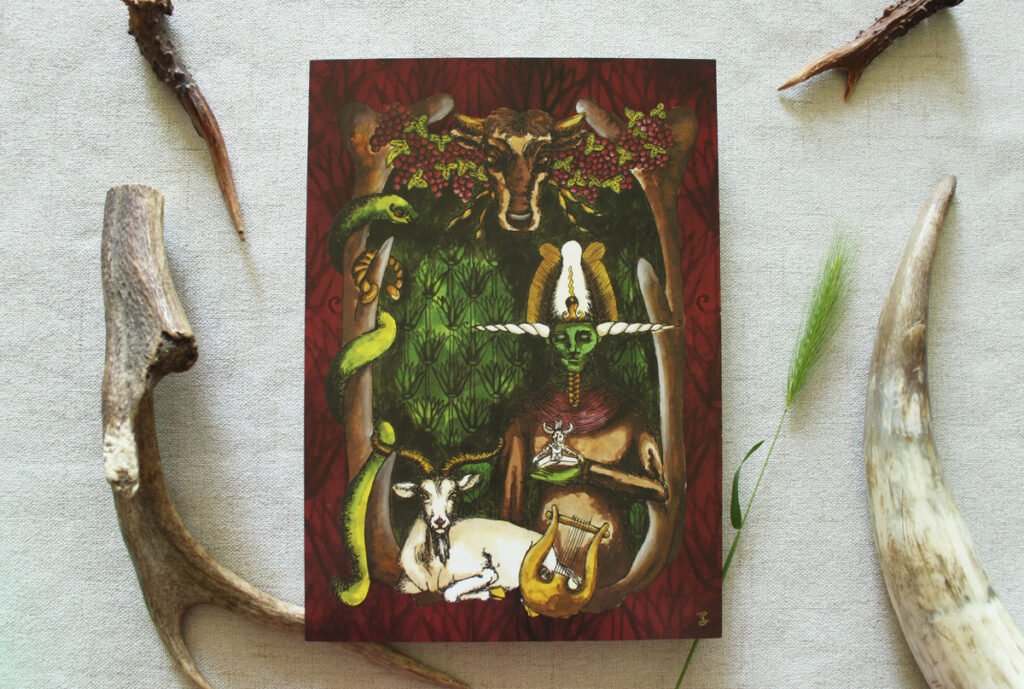Art and Creations by Imogen Smid

Art and Creations by Imogen Smid

Horned Gods” – Print available in my shop.Gods and Goddesses have taken on so many different forms throughout history and throughout the world. Some are in human form, some in animal form and some are a combination of both, also known as Therianthropic. Amongst these Therianthropic Gods, one of the very prevalent forms is The Horned God. The Horned God is often a fertility deity. The main Gods to pay attention to are: Cernunnos (Celtic), Pan (Greek), Dionysus (also Greek), Osiris (Egyptian) and Pashupati (Indian).
Cernunnos literally means the Horned One. One of the original images of Cernunnos was found on an artefact called the Gundestrup Cauldron. He is a man with stag antlers sitting crossed legged and holding both a torc (a round Celtic necklace) and a horned serpent. These two items can easily be visually associated with the male and female reproductive organs. This enhances the theory that he was worshipped as a fertility god. He is also to be found on the Gallo-Roman artefact, the Pillar of the Boatman. This is the only historical evidence of the name Cernunnos, although many subtle variations of the name have also been found.
Pan’s form is that of a satyr (a faun being the Roman equivalent): a man with goat legs and horns. He, and in fact all satyrs, have a great passion for dancing, playing music, drinking and chasing after nymphs (minor nature deities who often take the form of beautiful young maidens). Pan is a god of fertility and as he is also the god of bountiful places such as fields, groves and wooded glens. This also connects him to the season of spring, the time when these places come alive again after the harsh winter. This connection to spring also confirms him as being a symbol of fertility.
An associate of Pan and a god who was often followed by Satyrs, was Dionysus. He is mentioned in numerous ancient texts as being a horned God, especially in the Orphic Hymns. They name him as: “horned”, “two-horned” and “bull-horned”. This statement that he is “bull-horned” puts emphasis on the fact that Dionysus is a fertility god, as the bull was a Greek symbol of male fertility. Dionysus was the god of the grape harvest, wine and ecstasy. His staff, the thyrsus, is tipped with a pine cone which is a very recognisable fertility symbol is ancient Greek and Roman culture.
Heading a little to the South we reach Egypt where there is another horned God to be found, Osiris. He is the head of all Gods and was often represented with ram horns. In Ancient Egypt they worshipped specific animals as well as gods; the ram was one of these animals and was a symbol of fertility. Very well cared for ram statues were found at both Mendes and Karnak. Osiris was often depicted with a green face, a colour associated with vegetation and re-birth. A large amount of the land in Egypt is infertile, but the swelling of the Nile brings fertility every year and makes vegetation possible.
The last God to be mentioned is Pashupati. He is portrayed in a similar manner as to Cernunnos: human form in a cross-legged position bearing a large pair of horns on his head. Unlike Cernunnos, he is not depicted holding anything in his hands. What really confirms his connection to fertility in some people’s theories, and in my own, is that he is depicted with an erect penis, a symbol commonly used to portray fertility gods.